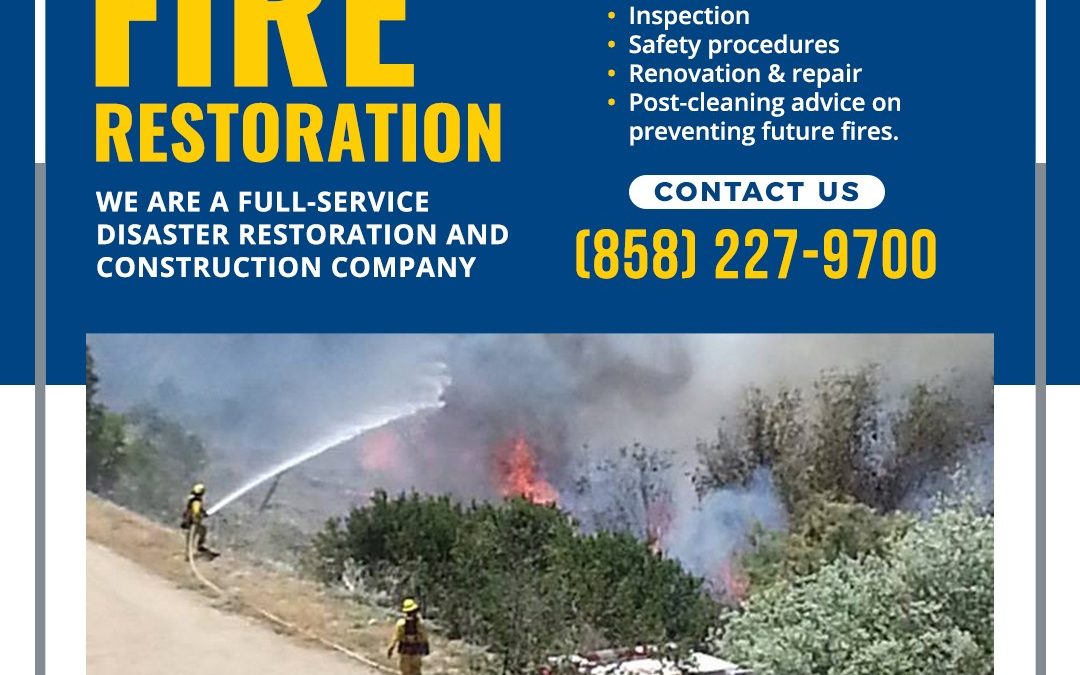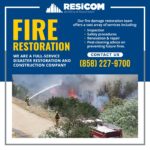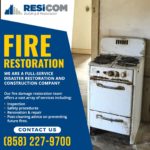Resicom Building and Restoration is a full-service construction and damage restoration company in Escondido, CA. Their technical skills are only a fraction of what makes the design, build, and restoration team extraordinary. The business is built upon relationships first and projects second.

A leader in both construction and restoration in Southern California, the company provides general contracting and disaster mitigation and restoration services. When disaster strikes, Resicom Building and Restoration is ready 24/7. The team does not stop until the damage is repaired.
Types of Fires
No two structural fires are the same. Each fire damage event, whether at a residential or commercial location, has its own unique signature. This signature reflects the materials and chemicals involved in the fire. Fires are classified into five different types. Understanding the different fire classifications will help in determining how to extinguish the fire. It will also help victims of fire damage realize that a fire of any type needs a trained, knowledgeable, and well-equipped fire and water damage restoration company to address the cleanup and restoration challenges.
Class A
Class A fires involve paper, wood, fabrics, trash, or plastics. Class A fires are often started by a match or an overturned candle. Most accidental fires fall into Class A and can be extinguished with water, foam, dry powder, or wet chemical extinguishers. The fire itself may have been only small to medium in size and limited to a particular area. However, the residue from the fire extinguisher complicates the cleanup and restoration process. Enlisting the services of cleanup and damage restoration technicians with the proper training, equipment, and safety gear is highly recommended.
Class B
More dangerous than Class A fires, Class B fires involve flammable liquids and gases like gasoline, alcohol, paint, petroleum grease, butane, methane, and propane. Using water to extinguish a Class B fire is not recommended. Because they remove the oxygen feeding the flames, CO2, foam, and dry powder extinguishers are recommended for use on flammable liquids. Dry powder extinguishers are recommended for fires involving flammable gases.
Class C
Class C fires involve electrical equipment. A fire caused by overloading a circuit or plugging too many cords into an outlet or power strip would be an example of a Class C fire. Faulty appliances, aging wiring, and outdated breaker boxes can lead to Class C fires. Industrial sites and old homes are often scenes of Class C fires. If possible, disconnect the burning object from the power source or shut off the electricity to the affected area. Then, use a CO2 or dry powder extinguisher to put the fire out. Avoid using water or any chemicals that may conduct electricity.
Class D
Class D fires involve ignitable metals. Commercial and industrial locations are the most common locations for Class D fires. Titanium, magnesium, potassium, sodium, and aluminum are examples of metals that can combust under certain conditions, such as extreme heat. Use only dry powder to extinguish a Class D fire since the powder absorbs the heat from the fire.
Class K
Class K fires often involve the kitchen. Fires from cooking oils, grease, and animal or vegetable fats are designated as Class K. Do not use water to extinguish the flames. The result could destroy the entire structure. Turn off the stove or oven, remove the fire from the heat source, and use a wet chemical extinguisher, if needed, to extinguish the flames. Wet chemical extinguishers produce a foam over the burning oil.

Understanding the different types of fires and how to extinguish each type can save homes and lives. Even small fires produce dangerous soot, toxic gases, and hazardous chemicals that may result in serious health issues or death. A fire damage event is often more complex than water damage or mold damage incidents. A housefire often involves large amounts of water damage if the fire department extinguished the flames. In damage events involving a smaller fire, the use of a fire extinguisher impacts the cleanup and restoration process by introducing more chemicals into the area, necessitating the services of a professional fire damage restoration team.
The experts at Resicom Building and Restoration can handle every facet of a fire and water damage incident, including the cleanup of chemicals from the fire itself and the fire extinguisher, used to put out the flames. For more information about fire damage restoration, contact the office by phone at (858) 227-9700 or email info@resicom.com.
Distribution Links +
- wicz.com
- ktvn.com
- wboc.com
- snntv.com
- rfdtv.com
- wfmj.com
- htv10.tv
- central.newschannelnebraska.com
- metro.newschannelnebraska.com
- southeast.newschannelnebraska.com
- midplains.newschannelnebraska.com
- northeast.newschannelnebraska.com
- plattevalley.newschannelnebraska.com
- panhandle.newschannelnebraska.com
- rivercountry.newschannelnebraska.com
- wrde.com
- wpgxfox28.com
- wdfxfox34.com
- lifestyle.mykmlk.com
- wtnzfox43.com
- lifestyle.3wzfm.com




